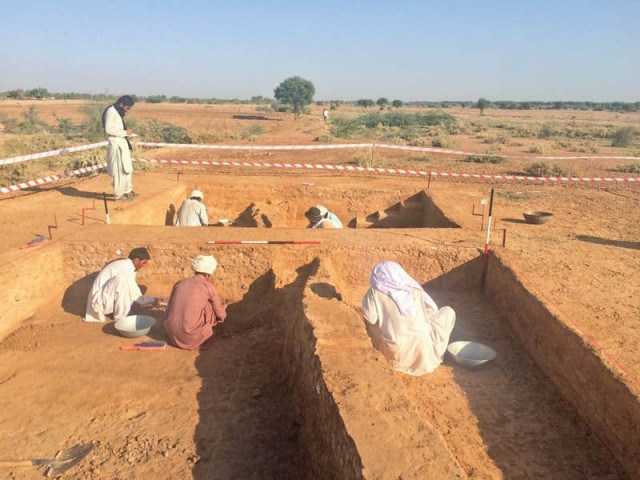Indus Valley Civilisation: Extending the roots of our ancestry
Artefacts discovered at Sikandar South, shaping the ancient civilisation through the nation

Locals search for artefacts at an excavation site in Sikandar South, DI Khan. PHOTO: EXPRESS
Antiques have been discovered in Sikandar South, a small village in DI Khan, on Wednesday that date back to 2,600 BCE. The recent excavations provide details on the expansion of the Indus Valley Civilisation into Khyber-Pakhtunkhwa.
“We have found remains dating to 2,600 BCE which belong to the Indus Valley Civilisation,” said Director of Archaeology and Museums Dr Abdul Samad, who is also the project director of the excavation.
The project at Sikandar South started a month ago in collaboration with the department of archaeology.
Although the area is economically underdeveloped, this archaeological site was first identified by the British. They found the site rich with socio-cultural heritage, archaeological antiques and remnants of a glorious past. However, there has been no excavation done in the past to prepare a culture and heritage profile of the area. This is the first excavation project to be undertaken in the area.
Dr Samad added the history for the region could be traced back to 5,000 – 2,600 BCE. Last year, excavations at Rahman Dheri, 14 kilometres north of DI Khan, revealed objects dating back to 3,500 BCE. K-P is mainly known for the Gandhara civilisation
in Charsadda.
“A majority of people know about Gomal Valley and its significance in the Indus Civilisation. It is the birthplace of the ancient civilisation,” Dr Samad said. Complete excavation of the valley will provide very detailed information about the expansion of Indus Civilisation from Sindh and other areas to this part of K-P. “There are some 100 sites in Gomal Valley that can shed light on the emergence of the Indus Civilisation,” Dr Samad said.
The Indus Valley Civilisations at Mohenjodaro and Harappa were discovered in 1920-21 and often denoted by their respective locations. According to archaeologists, the civilisation spanned a period of two millennia, from 3,200 to 1,300 BCE. Late Professor Ahmad Hasan Dani, famous Pakistani archaeologist and Sanskritologist, discovered remains of the civilisation at Gumla, few miles from DI Khan. Professor Farzand Ali Durrani, who excavated Rahman Dheri, provided details on the extension of this civilisation in the South of K-P.
Dr Zakirullah from the archaeology department said Sikandar South is unique and eminent. He said these efforts will help promote the nation’s rich traditions, culture and old heritage.
Published in The Express Tribune, November 19th, 2015.













COMMENTS
Comments are moderated and generally will be posted if they are on-topic and not abusive.
For more information, please see our Comments FAQ